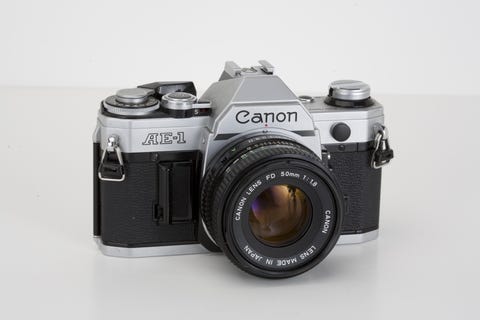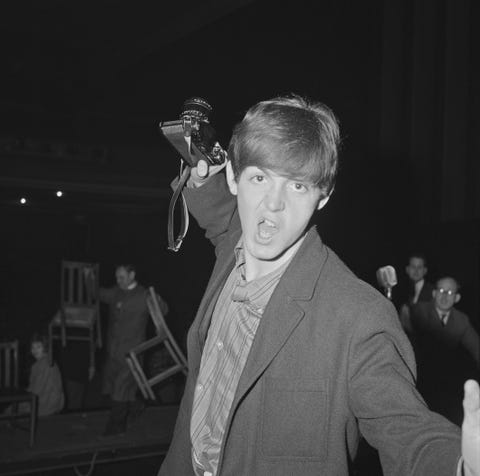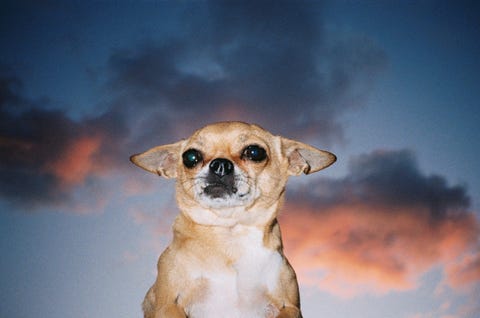cheap film cameras for beginners
Chances are you have a mate who carries a vintage camera at all times. Spends each weekend wandering aimlessly around the Barbican, photographing leaves and balconies. Would defend their Instagram 'aesthetic' with their lives, if it came down to it.
Still, what an Instagram it is! And they're not alone in their obsession. Driven by a desire to stand out from the brunch crowd and grow their follower count, millions of people have dived into the world of #35mm cameras over the past few years – and needless to say, you want in too.
Well, It's not as simple as you might think. But who better to start you on your journey than John Wade, author of Retro Cameras: The Collector's Guide to Vintage Film Photography? No one, that's who...
Buying
"There's bags of stuff on eBay, and that's probably the first place to start," says John. "A 35mm single-lens reflex (SLR) camera would be your best bet."
Opt for a model from one of the big five brands from back in seventies: Canon, Minolta, Nikon, Olympus or Pentax. They're all basic, hardwearing, top quality and shouldn't come at too much cost. 35mm film cassettes can also be bought cheaply on Amazon.
"You can pick a classic, pre-owned Canon A1 up for around £80, or an AE-1 Program for slightly more, and they can do everything. But any camera with a program mode is good for a beginner." Program is an exposure function that does all the hard work for you, until you feel ready to manually alter your shots.

Getty Images
Famed for bridging the gap between photographers and hobbyists in the seventies, both Canon cameras come fitted with 'shutter priority', which means "you can choose your shutter speed, and your camera will automatically choose an aperture" (that's the hole in the lens which dictates how much light travels through the camera body). Other great options include the (almost) indestructible Pentax K1000 and the Olympus OM-1.
If you want to get your hands on the camera before you buy, then check out vintage markets – but without the safety net of eBay or Amazon, you have to know what to look out for. "As you pick them up, go through all the shutter speeds and make sure they're not sticking - that is, opening but not closing. That's your first port of call."
It's also worth checking if replacement batteries are still available for your chosen camera. "Mercury sales were deemed a bit dangerous in the late eighties, so many batteries have been discontinued." Give it a Google before you buy, just in case.
One more thing: if you authentically want to pursuit film photography, then steer clear of Lomo cameras which produce those once-trendy but low-quality shots that took over Instagram a few years ago - the ones where colour bleeds into the edges of the frame.
"A lot of people refer to all old film cameras as Lomo, but they're not. Lomo cameras have got nasty old plastic lenses, and produce imperfect pictures. I spent my life trying to avoid taking shots like that!"
Understanding your camera
If you want to move past automatic mode, then you'll have to get your head around the shutter speed, aperture and focus functions. "For a picture to look natural, it needs to be correctly exposed," says John.
The aperture controls the light let through the lens, and the shutter speed decides how much light is allowed to reach the film. According to John, different shots require different combinations of the two.

Getty Images
"If you're interested in photographing sport, for example, you'd want a fast shutter speed to capture the action - and that means you need a wide aperture. If you're photographing landscape, you'll rely on the aperture, and then compensate with a light shutter speed." Fast shutter speeds freeze the action, while slow speeds can be used to blur movement.
Aperture settings are generally set on a ring around the camera lens, while shutter speeds can be found on the top plate dial (the opposite is the case in digital photography). Generally speaking, it's always better to overexpose than underexposure your film, whether it's black & white or colour.
But if it all sounds a bit confusing, don't worry. The best results will come from experimenting with your camera, and finding what settings work for you. "Learn what the camera's doing and start to do it yourself. You'll have more fun."
With that in mind, it's probably best to use the shoot with the same film to begin with. Different brands offer different results, and you'll find it harder to analyse and adapt your approach if there are too many variables at play. Start off with cheaper film and move up the ladder as your progress. Low ISO film (50-200) is better for sunny conditions, while higher ISO film (400+) suits dreary weather and indoor photography.

Getty Images
Developing your shots
Unless you plan on covering your bedroom windows with bin liners and creating your own dark room, you're going to be splashing out on developing photos. "At one time it was dirt cheap, but the prices have just about tripled. You can develop colour film – 36 pictures – at Snappy Snaps for around £15."
The bin liners are sounding more appealing now, aren't they? "Building your own dark room is a hell of a lot cheaper than it used to be," says John. "Very few people want the equipment nowadays, so you can buy an enlarger for a few quid on eBay. There are companies which still specialise in the chemistry, too. We used to black out the downstairs toilet, so that nobody could get in."
Your housemates probably won't approve of that, so stick with Snappy Snaps. They'll even give you the shots back on a CD, so you won't have to mess about with a scanner, or send them to you by email in a digital format.
There are also a lot of programs that will allow you to digitalise your processed negatives without a dark room. VueScan, which is available on Windows, Mac OS X and Linux, will help you scan images so that you can tinker with them on software like Adobe Lightroom and photoshop.
Digital scanners are available, to save you a lot of hassle. With the Kodak Scanza, you simply feed old 35mm film into it and they'll automatically be converted to JPEG files and transferred onto your device. It even features a high-def built-in colour display.
Photography tips
"When you look through the viewfinder of a camera, it's very easy to to have tunnel vision," warns John. "You focus on the subject in the middle of the frame and nothing around it. Then you press the shutter, and your subject is small. Make sure to take in the whole image through the viewfinder."
When it comes to subjects, John believes it's all in the details. "Strange patterns in brickwork, and that kind of thing. Really start looking at things you've taken for granted in the past."
But ultimately, 35mm is best suited to snapshots of life. "If you look back at pictures that were taken fifty, hundred years ago, it's not the lovely landscapes that are interesting – it's the snapshots. Because you see life as it actually was, rather than an idealised version."
In this overly filtered social media age, perhaps that explains why the 35mm renaissance shows no sign of stopping yet.
We decided to reach out to our favourite accounts on Instagram, from amateur photographers to award winners, to get some invaluable tips and tricks on the best ways to get the most out of your camera. We'll be regularly adding to the list over the coming months.
Dani Brown – @xdani_brownx

Dani Brown
- I have been shooting film for two years now. Once you start, the beautiful, natural and softer look that film gives you can be addictive.
- For me personally, the simpler the image the more impact it has. I chase light and colour as a priority, and you don't need to be on holiday or somewhere spectacular to start shooting. I think it is important for people to notice and appreciate familiar surroundings, perhaps even more so given the current pandemic, which sees us limited in where we can travel to, and with whom we interact.
- Flash: Experiment with flash! If it's overcast, dusk, or at anytime at all, pop the flash out for a couple of shots. You might get some unexpected, impactful results.
- 35mm film: Film is expensive. My cheaper, go-to option is the very versatile, Kodak Ultramax 400. For everyday shooting, no matter the light, Kodak Ultramax 400 always seems to deliver (for me anyway). I find it provides fine grain and deep saturation. On special occasions, I use Cinestill 50D and Portra 800.
- Getting your films developed: When I first started out, I was getting my films developed at Boots and Snappy Snaps, much to the horror of fellow film photographers. I quickly realised this is a big NO! Find your local film labs, or hop online. I highly recommend both Brighton Film Lab (colourstream) and Southsun Film Lab (mail) based in Wales.
- Don't overthink it: Have fun and experiment. The nature of film means there will be disappointments along the way, but its all part of the learning process. For me, that's also what makes shooting film much more rewarding than its digital counterpart.
2019 Taylor Wessing Portrait Prize Winner Pat Martin
- Choose one camera, one lens, one film stock. Get to know it really well. A camera is a tool at the end of the day, and it's best to keep it simple.
- Shoot slow and nurse every frame on the roll (For medium format, I only have 10 frames per roll, so I have to really consider each image before I push the button). But if you have extra film and lunch money, shooting more rolls of film of the same subject allows for more creative flexibility. Be flexible and allow for spontaneity.
- As a general rule when planning to photograph a subject, I tell myself three rolls at least (30 frames) I try to meditate on what I want my first image to be, then there's 29 more frames to build from there.
- Lighting: if you cant control the light, try to control the timing. I know I always gravitate towards images lit by the sun, and timed usually around sunrise and sunset. When possible, I push to reserve my "camera time" for those hours.
- My favourite all around day to day camera/film: Pentax 67, Kodak Portra 400.
A step-by-step guide to finding the perfect beginner camera
Research: First thing's first, you'll want to find your model. As you've probably guessed by its name, Camera Wiki is a vast online resource for information on vintage film cameras (and every other type of camera, for that matter). Equally, there are plenty of websites with expert recommendations, including the UK-based Lightbox Darkroom, which offers affordable workshops too. You could even get in contact with a photographer on Instagram or YouTube if you're a fan of their work, and enquire about their model and approach (no promises they'll reply, though). The point is, put the time in to find the best option for you, both in terms of performance and aesthetic, and check to ensure that it's a smart choice; that the lenses available for that camera aren't prohibitively expensive, and that the batteries/film is still available. Don't fall under the misapprehension that you'll always be getting value for money, too – sometimes cameras shoot up in price due to rarity, pop cultural significance or brand reputation, meaning that their prices can be overinflated. A beginner really just needs a good, functioning, affordable model.
Raid eBay and specialist sites: As we mentioned above, the auction site is full of vintage camera options – and there are few steps you can take to ensure you get a good deal. First of all, set up eBay alerts around your chosen camera, and check how much it usually goes for by clicking on the filter by your search and ticking 'Sold Items'. It goes without saying you should pay attention to the seller's feedback score and the full description, and then bid high and late to beat (other) snipers. Meanwhile, sites like Harrison Cameras and Camera World are transparent and trustworthy.
Independent camera shops: Once we're allowed to pop into shops again, it's worth travelling to indie camera shops in your local area. You'll be able to lean on and learn from their expertise and passion, and possibly engage with a local community of photographers. You can find a good list of UK options right here.
This content is created and maintained by a third party, and imported onto this page to help users provide their email addresses. You may be able to find more information about this and similar content at piano.io
cheap film cameras for beginners
Source: https://www.esquire.com/uk/culture/a20112200/how-to-use-35mm-film-cameras-buying-guide/
Posted by: preusserforthand.blogspot.com

0 Response to "cheap film cameras for beginners"
Post a Comment